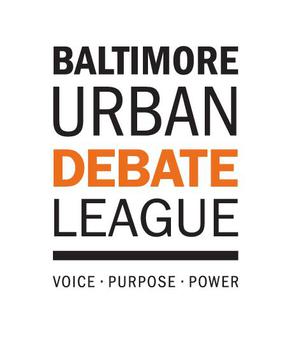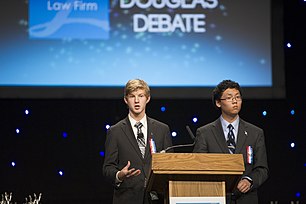
The National Speech and Debate Association (NSDA) is the largest interscholastic speech and debate organization serving middle school and high school students in the United States. It is also the national authority on public speaking and debate.
The Canadian University Society for Intercollegiate Debate is the national organization which governs all English language competitive university debating and public speaking in Canada. It sanctions several official annual tournaments and represents Canadian debating domestically and abroad. Its membership consists of student debating unions, sanctioned by their respective universities, from across Canada. CUSID has been described as "a student-run, parliamentary debate league with close ties to the American Parliamentary Debate Association".

Debate is a process that involves formal discourse, discussion, and oral addresses on a particular topic or collection of topics, often with a moderator and an audience. In a debate, arguments are put forward for common opposing viewpoints. Debates have historically occurred in public meetings, academic institutions, debate halls, coffeehouses, competitions, and legislative assemblies. Debates have also been conducted for educational and recreational purposes, usually associated with educational establishments and debating societies. These debates emphasized logical consistency, factual accuracy, and emotional appeal to an audience. Modern forms of competitive debate also include rules for participants to discuss and decide upon the framework of the debate.
Lincoln–Douglas debate is a type of one-on-one competitive debate practiced mainly in the United States at the high school level. It is sometimes also called values debate because the format traditionally places a heavy emphasis on logic, ethical values, and philosophy.
Policy debate is an American form of debate competition in which teams of two usually advocate for and against a resolution that typically calls for policy change by the United States federal government. It is also referred to as cross-examination debate because of the 3-minute questioning period following each constructive speech. Evidence presentation is a crucial part of policy debate. The main argument being debated during a round is to change or not change the status quo. When a team explains why their solvency is greater than the opposition's, they compare advantages. One team’s job is to argue that the resolution— the statement that we should make some specific change to a national or international problem —is a good idea. Affirmative teams generally present a plan as a proposal for implementation of the resolution. On the other hand, the Negative teams present arguments against the implementation of the resolution. In a single round of debate competition, each person gives two speeches. The first speech each person gives is called a “constructive” speech, because it is the speech when the first speaker positively, without rebuttal that has not occurred, presents the basic arguments they will make throughout the debate. The second speech is called a “rebuttal”, because this is the speech were each person tries to rebut the arguments made by the other team, while using their own arguments to try to convince the judge to vote for their team. The Affirmative has to convince the judge to vote for the resolution, while the Negative has to convince the judge the Negative's position is a better idea.
Individual events in speech include public speaking, limited preparation, acting and interpretation are a part of forensics competitions. These events do not include the several different forms of debate offered by many tournaments. These events are called individual events because they tend to be done by one person unlike debate which often includes teams. This distinction however is not entirely accurate any more given the addition of duo interpretation events and forms of single person debate. Competitive speech competitions and debates comprise the area of forensics. Forensics leagues have a number of speech events, generally determined by geographical region or league preference. While there are several key events that have been around a long time, there are several experimental events around the country every year that can be limited to individual tournaments. Forensics leagues in the United States includes the National Speech and Debate Association, the National Christian Forensics and Communications Association, the American Forensics Association, the National Forensics Association, the Interstate Oratorical Association and Stoa USA. Organized competitions are held at the high-school and collegiate level. Outside of the rules for each event provided by the individual leagues, there are several cultural norms within each region that are not written into law but are almost always followed. Rules for time limits vary by event and by individual tournaments, but there are penalties in every event for exceeding the time limits though the severity of the penalty widely varies.
The National Parliamentary Debate Association (NPDA) is one of the two national intercollegiate parliamentary debate organizations in the United States. The other is the American Parliamentary Debate Association. Its membership is national with participating schools throughout the country. In 2015, NPDA was the largest debating organization in the United States with around 200-250 participating schools in any given year.
Public forum debate is a widespread form of pre-k elementary and middle and high school competitive debate which centers on current events and relies on both logic and evidence to construct arguments. Invented in the US, Public Forum is one of the most prominent American debate events, alongside policy debate and Lincoln-Douglas debate; it is also practiced in China and India, and has been recently introduced to Romania. Individuals give short speeches that are interspersed with 3 minute "Crossfire" sections, questions and answers between opposed debaters. The winner is determined by a judge who also serves as a referee. The debate centers on advocating or rejecting a position, "resolve", or "resolution", which is usually a proposal of a potential solution to a current events issue. Public Forum is designed to be accessible to the average citizen.
The American Debate Association began in 1985 as an intercollegiate debate association. It uses the resolution selected by the Cross Examination Debate Association and the National Debate Tournament. Currently they have 40 member schools. Its current president is Danielle Verney-O'Gorman, Director of Debate at the United States Naval Academy.

The American Forensic Association is an American organisation which promotes and supports competitive debating and public speaking in high schools and colleges in the United States.
Parliamentary debate is an academic debate event. Many university-level institutions in English-speaking nations sponsor parliamentary debate teams. In addition the format is currently spreading to the high school level. Despite the name, the parli is not related to debate in governmental parliaments beyond formal speaker titles such as "Opposition Leader" and "Prime Minister".
Extemporaneous Speaking is a speech delivery style/speaking style, and a term that identifies a specific forensic competition. The competition is a speech event based on research and original analysis, done with a limited-preparation; in the United States those competitions are held for high school and college students. In a Extemporaneous Speech competition, enrolled participants prepare for thirty minutes on a question related to current events and then give a seven-minute speech responding to that question. The extemporaneous speaking delivery style, referred to as "off-the-cuff", is a type of delivery method for a public presentation, that was carefully prepared and practiced but not memorized.
An urban debate league (UDL) is a group of high school policy debate teams from urban high schools in the United States. UDLs are generally located in large cities throughout the United States and work predominantly with minority students.
Inter-collegiate policy debate is a form of speech competition involving two teams of two debaters from different colleges or universities based on a resolution phrased as something the United States federal government "should" do. Policy debate also exists as a high school activity, with a very similar format, but different leagues, tournaments, speech times, resolutions, and styles.

The Baltimore Urban Debate League, is an American, non profit, urban debate league that aims to educate and mentor inner city middle school and high school students in the Baltimore, Maryland area.
The Bancroft Literary Association and the Carrollton-Wight Literary Society are two competitive forensic societies at the Baltimore City College and are the formal names for the school's speech and debates teams. Founded in 1876 and 1878 respectively, the Bancroft and Carrollton-Wight Societies are the oldest literary societies at a public high school in the United States. Historically, the two societies competed mainly between themselves. The rivalry culminated each year with an annual debate. In the 20th century, the societies began to compete with other secondary schools and some universities. At the time, the teams' most notable rival was Baltimore Polytechnic Institute, City College's chief rival in sports and academics. The Bancroft and Carrollton-Wight Societies disbanded for a time in the 1980s and early-1990s, but were revived in the late-1990s. Baltimore City College is a charter member of the Chesapeake Region of the National Forensics League and the National Catholic Forensic League, and is founding member of the Baltimore Catholic Forensic League and the Baltimore Urban Debate League.

The William Pitt Debating Union (WPDU) is the debating society of the University of Pittsburgh. Falling under the auspices of the Department of Communication, the WPDU is a co-curricular program and hub for a wide range of debating activities, including intercollegiate policy debate, public debate, and debate outreach. One of the oldest collegiate debating organizations in the nation, the WPDU grew from the University’s Division of Public Speaking in 1912. Throughout its history, the WPDU has regularly participated in national and international competitions, including capturing the affirmative team two-man debate national championship at the 1947 Grand National Forensic Tournament, and appearing 45 times at the National Debate Tournament, where it captured the 1981 national championship. The WPDU is located in the heart Pitt's campus and is housed on the fourteenth floor of the Cathedral of Learning. The WPDU also offers scholarships to top team participants.
James John Unger was the premier coach, teacher and theorist of intercollegiate policy debate in the United States during the 1960s through the 1980s.

The Yale Debate Association (YDA) is Yale University's only competitive intercollegiate debate team. Founded in 1908, it is the most prolific winner of the American Parliamentary Debate Association's Club of the Year award. The YDA was also the first American team to win and have the top speaker at the modern World Championships. Currently, the YDA is the fourth-ranked collegiate debate society in the world, and the highest in North America.
Stoa USA, also referred to as Stoa, is a Christian homeschool forensics organization in the United States. It is one of the four major national high school forensics organizations: the others are the National Speech and Debate Association (NSDA), National Catholic Forensic League (NCFL), and the National Christian Forensics and Communications Association (NCFCA).








